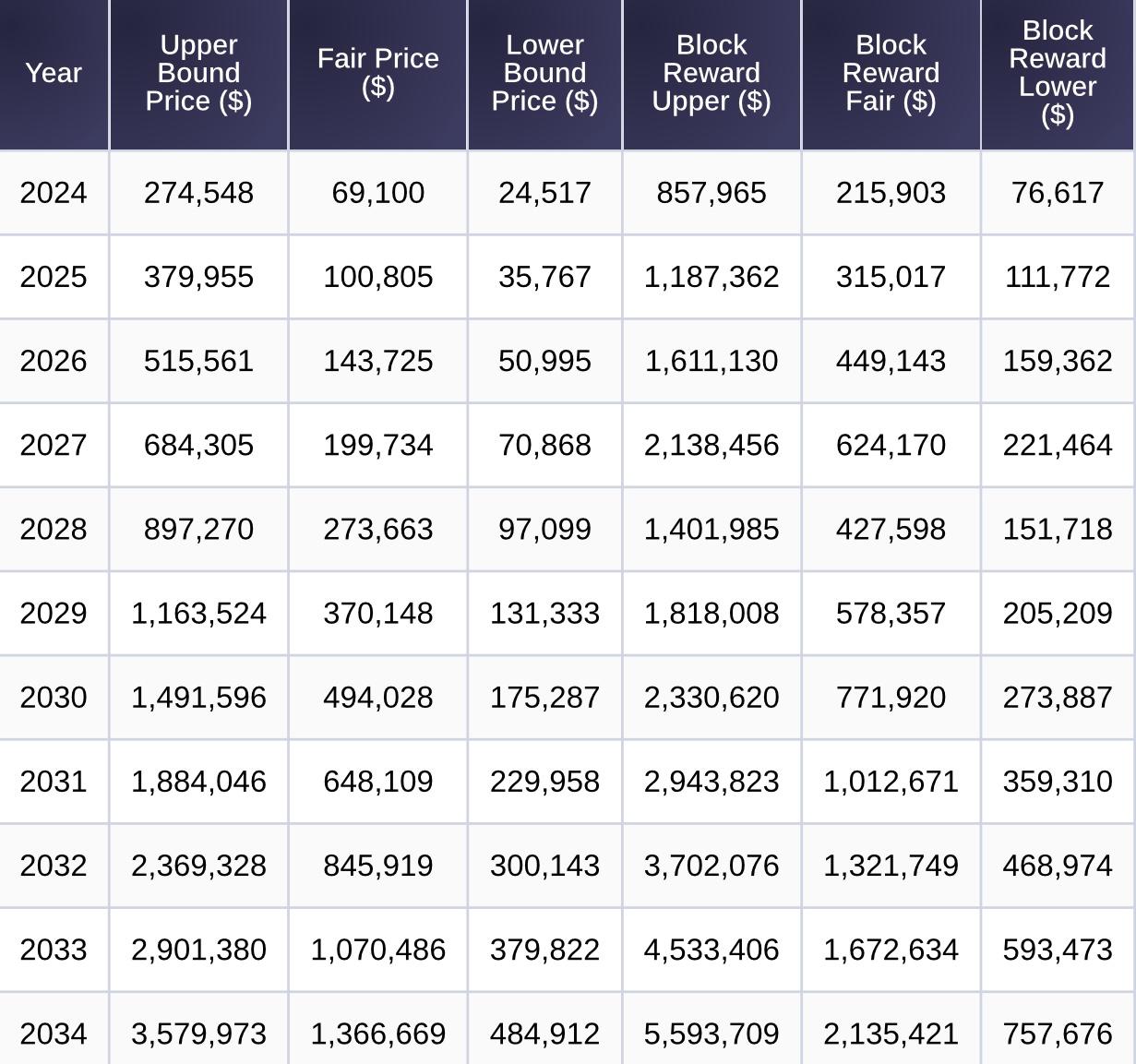The bitcoin block reward is one of the significant components of the mining environment that is expected to undergo dramatic transformation in the following decade. As per a modern prognosis based on the Power Law model, the probability of new Bitcoin block rewards could increase by up to 2,900% – to $5.5 million per block by 2034 for each block as stated in the goal and objectives of the project. If this forecast turns out to be true, then it is a large potential for Bitcoin miners even though this path is not without obstacles.
The Power Law Model and Its Predictions
Using the Power Law model by Giovanni Santostasi, future projections of the Bitcoin price and its synchronized block reward have been made. A recent analysis by CryptoSlate shows that the compounding Anticipated Return model points to the price of Bitcoin skyrocketing over the decade. This, in turn, would mean a massive explosion in the number of Bitcoin hashes produced and therefore an equally massive explosion in block rewards.
According to this model, the upper bound price of Bitcoin could rise from almost $274,548 in 2024 up to $3,579,973 by 2034. With these prices in conjunction with expected future halvings and transaction fees, it is possible for Bitcoin block rewards to rise from about 857,965 in the year 2024 to about 5,593,709 in the year 2034. But they raise one important point: these calculation do not assume the mining fees, has rate and the difficulty of the Bitcoin network.
Bitcoin miners have to be cautious though, as mentioned in the Power Law model, there might be also a tendency towards less optimistic prices. The lower bound price predictions also show potential increases, with block rewards estimated to range from $76,617 in 2024 up to $757,676 in 2034. This underlines the fact that efficiency and cost control are the main stimuli for performance in an environment where incentives are not very predictable.

Challenges and Risks for Miners
There are several challenges that may affect the profitability of mining bitcoin through block rewards although the possibility of the rewards increasing is promising. The halving events, which happen around every four years, will keep on decreasing the base pay per block. After the next halving their base block reward figure will be below the current figure of 3.125 bitcoins, which means that transaction fees became relatively more significant for miners’ income.
”Miners will have to conform to a new environment in which the opportunities for maximising return from a single block and transaction fees matter,” said CryptoSlate’s spokesperson. The importance of miners to keep on improving, especially in view of the high hash rates, and the advancing network difficulty is also captured in this statement. Mining operations are rapidly becoming competitive where those without the means to invest in more energy efficient technologies or any other forms of revenue generation risk folding.

The other set of forecasts provided by the Power Law model point to the direction that miners’ profit might be slightly slimmer if Bitcoin prices do not increase in the predicted way. Higher operational costs and difficulties in mining, could lead to potential erosion of gains hence the need by the miners to undertake enhancement of their operations.
Implications for the Future of Bitcoin Mining
Consequently, it is possible to expect the future of Bitcoin mining to be determined by a narrow correlation of growing rewards and growing difficulties of mining activities. If the Power Law model’s predictions are true, the absolute value of Bitcoin block rewards in fiat may increase dramatically. But, getting to these rewards will not be an easy run as people may presume. Thus miners will have to invest in better equipment and find ways to monetize their excess electricity or the work on other services related to the Bitcoin.
Yet another important condition can be considered the dependence on transaction fees. With Halving, the block rewards reduce and to support the operations, miners will depend on the transaction fees. This might result in higher charge for employing the Bitcoin system especially at the time of a great activity in the network. “Transaction fees are also expected to increase and therefore the level of transaction activity will become a major driver of profitability of mining,” added a CryptoSlate analyst.
The risks are nonetheless great but the prospects are even bigger. If Bitcoin prices were to equal the upper bound estimations of the Power Law model, miners might well earn daily rewards of $792 million, and weekly rewards of $5. 5 billion by 2034. These numbers argue the great potential for whoever may master the dynamics in the world of Bitcoin mining.
End Note on Bitcoin Block Rewards Predictions
The Power Law model’s point that block rewards of Bitcoin are likely to grow to $5.5 million by 2034, Some are Opportunities for the mining fraternity while others are Challenges. The opportunity to get high profits cannot be doubted at the same time miners face such challenges as the possibility of a sudden change in the rate of difficulty, high operating costs, and increasing the degree of dependency on fees for transactions. For this reason, the various miners who are participating in the Bitcoin network today will be better placed to reap in on the future benefits as the network grows when they change and work towards embracing the necessary changes. Keep following Daythere for latest updates on Bitcoin Block rewards.



















































































































